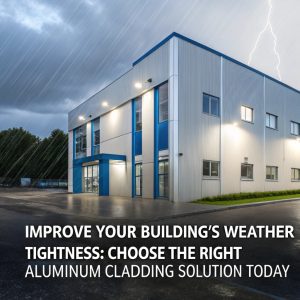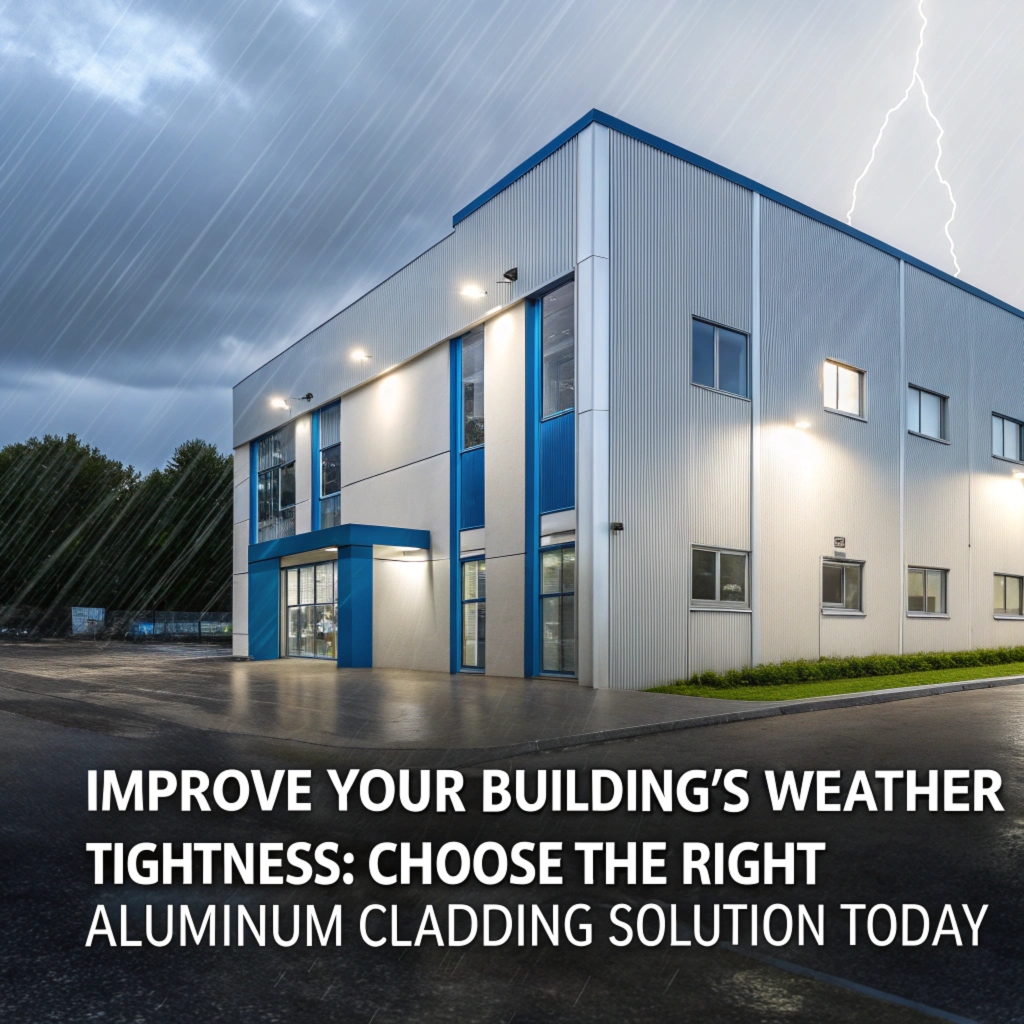
Is your home feeling like a cold, draftsy cave this winter?
Are you tired of paying for expensive heating bills and sacrificing comfort while trying to keep your building weather-tight? You’re not alone, we are here with Aluminum Cladding Solutions.
You may have already tried various solutions like sealing gaps and cracks with caulk or expanding foam, but results are short-lived at best.
By choosing the right aluminum cladding solution today, you can ensure a warm, secure home for years to come – saving you money and increasing your property value.
From traditional materials like vinyl and PVC to modern advancements in metal sheeting… discover how these options can transform your building’s weather tightness.
Weathershield Factor – What Sets Good Cladding Apart?
To have a well-sealed building, choosing the right aluminum cladding solution is crucial. This decision can make all the difference between weather tightness and let-downs from harsh weather conditions.
A good cladding material should provide an air-tight seal that prevents water infiltration while allowing for natural light to pass through. Good quality aluminum sheets possess this characteristic well. These are typically made using a combination of materials such as vinyl-coated, or galvanized steel with a durable coating.
The key here is the thickness and durability of these panels along with their rust resistance capabilities. A good cladding system will shield your building from cold winds, rain, sun rays and extreme temperatures which can lead to wear down over time.
A suitable choice should also be able to withstand heavy snowfall without showing any signs of damage or deterioration. This helps prevent costly repairs in the long run and maintain a safe living environment for everyone involved.
Material Matchmaking – Choosing the Perfect Aluminum for your Building
When it comes to building construction, selecting the wrong type of aluminum cladding can compromise your project’s performance. In this article, we’ll explore some key factors to consider when choosing an ideal material.
For projects requiring complex architectural designs, such as high-rise buildings or intricate metalwork, 6063-T6’s exceptional formability and weldability make it a top choice. This alloy has been successfully used in construction for high-end residential developments and commercial spaces, where its strength-to-weight ratio is crucial for precise fitting joints.
For structures exposed to harsh weather conditions like coastal areas or industrial sites, 8010 aluminum stands out as an excellent option. Its exceptional corrosion resistance protects against saltwater exposure’s “kiss of death,” ensuring your structure remains pristine even after years of use.
In applications where durability and appearance are top priority, such as wall cladding or roofing materials, consider 3003-H14’s unique benefits. This alloy possesses high formability and a strength-to-weight ratio that makes it ideal for exterior work. Imagine being the architect responsible for a sleek, modern skyscraper – with 8010 aluminum by your side, you can ensure its longevity without rusting away under harsh conditions.
When selecting an aluminum cladding solution, consider how much budget is allocated for maintenance costs and environmental factors like exposure to moisture. For instance, 3003-H14’s silver finish not only enhances the visual appearance of structures but also provides a sleek aesthetic that complements modern designs. By choosing the right material from the start, you can save time and money on repairs down the line.
Layering Up – The Importance of Double-Sided Cladding Systems
To Improve Your Building’s Weather Tightness: Choose the Right Aluminum Cladding Solution Today
When choosing an aluminum cladding solution, consider incorporating double-sided systems to ensure a weather-tight building design.
Benefits of Double-Sided Cladding Systems:
- In line with UK building regulations, double-sided cladding is now considered a requirement for minimizing air gaps and reducing moisture risks.
- Even small gaps between materials can result in significant energy waste (up to 30%) and increased maintenance costs over time: studies have shown that these losses add up to substantial financial burdens on homeowners.
Implementation Tips:
- Use flexible sealants or tapes to ensure excellent adhesion on both sides of the material layers, preventing moisture intrusion.
A well-designed double-sided cladding system should be implemented by:
- Installing a primary sheet with an air gap between it and a secondary layer, sealing any gaps to prevent condensation.
To minimize energy waste, consider installing reflective insulation in place of traditional materials.
Key Considerations:
- Double-sided systems can significantly reduce moisture risks associated with building design.
- Proper installation is crucial for optimal performance.
Seam Mastery – How to Seal and Prevent Water Infiltration in Your Roofing System.
For a weather-tight building, one crucial aspect is selecting an aluminum cladding solution designed for seamless joints or profiles. This means choosing a material that can withstand severe weather conditions like high winds and heavy rain.
Let’s face it – sealing your roof isn’t rocket science, but getting it wrong can be costly in the long run. I recall a project we worked on several years ago where water seeped into the gaps between seams, causing significant damage to the structure. It was a wake-up call for us to emphasize the importance of selecting an aluminum cladding sheet that is designed for seamless joints or profiles.
By choosing such a material, you can significantly reduce air leaks and prevent water infiltration, which not only ensures a secure seal around your building but also reduces heat loss in the winter and gains of heat in the summer. For instance, profiled systems like Hidden Fastener Systems (HFS) offer exceptional sealing capabilities while providing structural integrity.
When selecting different types of aluminum cladding for your roof, remember that wind and rain can be harsh on materials. Opting for a material with a high weather resistance rating, such as one from the ASTM A653 specification, is essential. This ensures that your building will withstand extreme conditions without sustaining damage or degradation over time.


To give you an idea of what it means to get this wrong, consider the following: if water infiltrates your roof and seeps into the seams, it can lead to costly repairs down the line. Not only might this cost you money out-of-pocket, but also compromise structural integrity and potentially damage your building’s foundation.
In conclusion, selecting an aluminum cladding solution is just half of a weather-tight building process. You must also consider your building’s overall structural integrity and climate-specific requirements to ensure it endures severe weather conditions for years to come. With this knowledge in hand, you can rest easy knowing that your roof will be protected against the elements – and so are you from those costly repairs down the line!
Weather-Proof Hinges, Fasteners, and Fixings
Building a tight seal is crucial for maintaining your structure’s integrity. Water can compromise its foundation in just one small crack, leading to costly repairs or even structural damage.
When it comes to maintaining that seal, you need a solid foundation. This starts with choosing the right aluminum cladding solution for your needs. But before we dive into those details, let’s talk about two crucial elements that make or break weather-proofing: hinges, fasteners, and fixings.
Choosing Hinges
Hinges are a critical component in ensuring smooth door operation while also preventing water entry points. Selecting the right hinges is vital for:
| IP Rating | Application |
| IP44 | High-traffic areas like entranceways (e.g., shopping malls, hospitals) |
| IP65 | Applications where the door is exposed to heavy weather conditions (e.g., coastal towns, high-altitude regions) |
Consider how different hinge types can affect door operation:
- Smooth motion: Ball-bearing hinges or soft-close hinges for a quiet and seamless experience
- Noise reduction: Hinges with rubber or nylon seals reduce noise pollution while maintaining functionality
- Reduced wear: Hinge designs with reinforced pins or screws minimize mechanical stress
When selecting hinges, also consider factors like weight capacity, door type (e.g., steel vs. wood), and environmental conditions.
Choosing Fasteners
Fasteners play a vital role in holding your cladding securely. When choosing fasteners for your building project:
* Material:
+ Aluminum: Lightweight yet corrosion-resistant
+ Steel: Strong and durable but can rust if not properly coated
+ Stainless steel: Corrosion-resistant and easy to clean, ideal for high-traffic areas or coastal regions
* Size:
Calculate the correct size of fasteners based on building design using formulas like the ‘rule of thumb’ 1:10 (fastener diameter / stud spacing)
Consider factors like material sustainability and environmental impact when choosing your preferred fastening system
Choosing Fixings
Fixings provide a final layer of protection against weather entry points. When selecting fixings:
* Weatherproofing materials:
+ Rubber or nylon seals create an impenetrable barrier
+ Stainless steel or aluminum with rubber washers offer durability and corrosion resistance
* Material compatibility:
+ Make sure the fixing material is compatible with your building’s foundation, cladding, and structural elements
For example, consider using self-tapping screws for wood framing while choosing galvanized steel fasteners for concrete foundations. Properly secured fixings prevent costly repairs down the line.
By understanding these key components of weather-proofing, you’ll be well-equipped to build structures that withstand even the toughest conditions.
section6
Choosing a suitable aluminum cladding system is crucial in ensuring a weather-tight envelope, which can significantly improve your building’s energy efficiency and reduce maintenance costs. With numerous types of materials available, each with its unique set of benefits and drawbacks, it’s essential to make an informed decision that meets specific needs.
Galvanized steel claddings are known for their excellent corrosion resistance but require a coating for added durability, which can be costly in the long run. In contrast, aluminum itself offers natural corrosion resistance when properly coated and is often considered more environmentally friendly due to its high recyclability rate.
When selecting an aluminum cladding system, it’s crucial to consider factors like structural integrity and wind load capacity. Imagine a building with a poorly designed envelope that fails under extreme weather conditions – the consequences can be dire. For instance, in 2019, a severe storm battered Sydney’s iconic Opera House, leaving millions of dollars’ worth of damage due to inadequate cladding design.


Industry standards such as AS/NZS 2634 (Australia) and EN 13814-1:2016 (Europe) provide guidelines for selecting materials that ensure weather-tightness. By following these regulations, building owners can minimize the risk of costly repairs and avoid safety hazards associated with compromised structural integrity.
A well-designed aluminum cladding system not only improves a building’s performance but also provides several economic benefits. For instance, reduced maintenance costs over time can translate to significant savings for property owners. Furthermore, selecting an appropriate material can increase a building’s resale value, making it more attractive to potential buyers in the future.
When choosing between different types of aluminum cladding systems, consider their compatibility with your building’s structure and wind load capacity requirements. Ensure that the chosen system is designed to withstand various environmental conditions without compromising its integrity. This will help prevent costly repairs down the line and ensure a safe living or working environment for occupants.
In conclusion, selecting an appropriate aluminum cladding solution requires careful consideration of multiple factors to ensure weather-tightness, structural integrity, and economic benefits. By making informed decisions based on industry standards and best practices, building owners can reap numerous rewards that extend beyond mere cost savings.
Section7
Choosing an aluminum cladding solution can be a daunting task due to the numerous options available. When it comes to maintaining a building’s weather-tightness, selecting the right material is crucial.
When choosing an aluminum clacking solution, there are four key factors that require careful consideration: durability, corrosion resistance, sustainability, and cost-effectiveness. For example did you know that poorly selected materials can lead to costly repairs or even structural damage? The statistics are alarming – according to a study by the National Association of Home Builders (NAHB), homes with inadequate weather-tight systems experience an average repair bill of over $7,000 per year.
Corrosion resistance is particularly critical when it comes to aluminum cladding. While galvanized steel is often used as an underlayment material, other corrosion-resistant options such as powder coating and zinc-rich primer are gaining popularity. However, selecting the right material can be tricky – common mistakes include neglecting to address surface preparation and applying a low-quality or unsuitable coatings system.
To ensure optimal results, consider materials with high corrosion ratings from organizations like the American Society for Testing Materials (ASTM) or the International Organization for Standardization (ISO). Here are some examples of corrosion-resistant aluminum cladding options:
| Material | Corrosion Resistance Rating | Advantages |
| Galvanized Steel Underlayment | ASTM A 780, ISO 14636-1:2014 | Provides added protection against moisture damage and rust |
| Powder Coating (zinc-rich primer) 100% PVC or polyester finish coat with a zinc-rich clear topcoat. Inhibits corrosion by providing a barrier between the metal surface and corrosive substances such as moisture, saltwater, etc.) | Offers durable long-lasting protection without compromising color or gloss retention |
| Galvanized Steel (without underlayment material) Corrosion resistance is directly related to thickness of the galvanized coating. Thicker coatings provide better corrosion resistance but are generally more expensive than thinner ones | Provides good corrosion protection for a shorter period when compared with thicker coatings, it still protects well over its lifespan and can be applied in a variety of environments |
Sustainable practices are also crucial when selecting an aluminum cladding solution. Look for products made from recycled materials or those that minimize environmental harm during production. For example, some manufacturers offer eco-friendly packaging options or recyclable components. According to the United States Environmental Protection Agency (EPA), the construction industry can significantly reduce its carbon footprint by adopting sustainable practices.
Budget constraints also play a significant role in deciding which aluminum cladding solution is best for your building. While more affordable options may require additional maintenance over time, they still provide essential protection against weathering. Higher-end options typically come at an increased cost but offer superior durability and performance. When selecting materials for this project consider that the average annual maintenance cost per square foot of a single family home can range from 20 to $50 depending on location.
Ultimately, it’s crucial to evaluate your specific needs when choosing an aluminum cladding solution. By considering factors such as corrosion resistance, sustainability, budget constraints and overall system requirements, you’ll be able to make an informed decision that keeps your structure safe and secure for years to come.
By the way:
Don’t let rust take hold – choose wisely
section8
Selecting a suitable aluminum cladding solution is crucial in ensuring your building remains secure and watertight. A poorly installed system can lead to costly repairs down the line.
When it comes to material selection, consider how you’ll use your structure and what kind of weather conditions it will be exposed to. For instance, if your building is located in a coastal area with high humidity or near rivers that flow into heavy rainfall zones, choose materials specifically designed for these challenges. These include:
- Corrosion-resistant coatings: Anodized aluminum or zinc plating can protect against environmental pollutants and saltwater damage.
- Durable options like G90 or G60 profiles: Higher gauge ratings provide added strength in harsh weather conditions.


A poorly installed cladding system will not only compromise your building’s performance but also void its warranty. It’s essential to choose the right installation technique for a watertight seal:
- Overlapping panels: Ensure proper alignment and ensure each section overlaps by at least 1/4 inch.
- Sealant application patterns: Apply caulk around windows, doors, or vents according to manufacturer specifications.
If you ignore these factors in your building’s aluminum cladding system, you’ll be left with costly repairs down the line. By selecting materials suited for specific scenarios and adhering to proper installation techniques, you can ensure a watertight seal that withstands even extreme weather conditions.
The Ultimate Weather-Tight Seal: Unlock Your Building’s Full Potential
Great buildings won’t compromise on weather tightness, and neither should you. A well-maintained building envelope is crucial for the longevity and efficiency of your structure. If neglecting a leaky or damaged cladding system allows water to penetrate, costly repairs are inevitable.
So, don’t gamble with structural integrity – take immediate action to seal those gaps. The sooner you address these issues, the less likely they become sources of future problems.
Choose the right aluminum cladding solution and reap the rewards: reduced maintenance needs and extended lifespan for your building envelope. Your investment in weather-tightness pays dividends when it comes time for repairs or replacements – minimizing downtime that can severely impact operations.
Take decisive action today to safeguard your facility, ensuring its integrity remains strong through stormy seasons and beyond.


